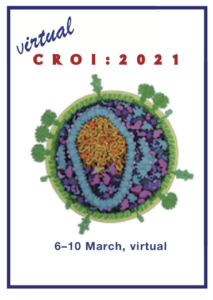Dual Regeneron mAbs casirivimab with imdevimab reduce transmission: interim results from phase 3 study
1 April 2021. Related: Conference reports, COVID-19: investigational drugs, COVID-19, CROI 28 (virtual) 2021.
 Simon Collins, HIV i-Base
Simon Collins, HIV i-Base
Another combination of dual nAbs – this time from Regeneron – also reported positive results compared to placebo in reducing the chance of SARS-CoV-2 infection from an interim analysis of a phase 3 study. [1]
This randomised, double-blind, placebo controlled study primarily looked at prophylaxis in household contacts at high risk of SARS-CoV-2, but also included a smaller treatment study in participants who were diagnosed positive at baseline.
Participants were randomised to either 1200 mg casirivimab/imdevimab (600 mg of each antibody administered subcutaneously) or to placebo, with interim results presented from the prevention data.
Significantly fewer participants in the active arm were diagnosed with symptomatic infection: 0/186 (0%) vs 8/223 (3.6%); OR: 0.00 (95% CI: 0.00 to 0.69). There were also significantly fewer infections with SARS-CoV-2 PCR levels >1000 copies/mL: OR: 0.00 (95% CI: 0.00 to 0.37).
Although the overall rate of SARS-CoV-2 positive infections was reduced, this was not statistically significant: 10/186 vs 23/223; OR 0.49 (95% CI: 0.20 to 1.12).
Placebo recipients having 100-fold greater peak viral load and SARS-CoV-2 became undetectable within a week in the active arm but persisted in 40% of placebo recipients at 3-4 weeks. Statistical significance of both these differences was not reported.
Earlier results from this combination reported a 0.5 log reduction at day 11. [2]
References
- O’Brien MP et al. Casirivimab with imdevimab antibody cocktail for COVID-19 prevention: interim results. CROI 2021, virtual. Late breaker oral abstract 123.
https://www.croiconference.org/abstract/casirivimab-with-imdevimab-antibody-cocktail-for-covid-19-prevention-interim-results/ (abstract and webcast) - Two different dual antibody treatments each reduce SARS-CoV-2 viral load by >0.5 log. HTB (22 January 2021).
https://i-base.info/htb/39718
This report was first published on 19 March 2021.

